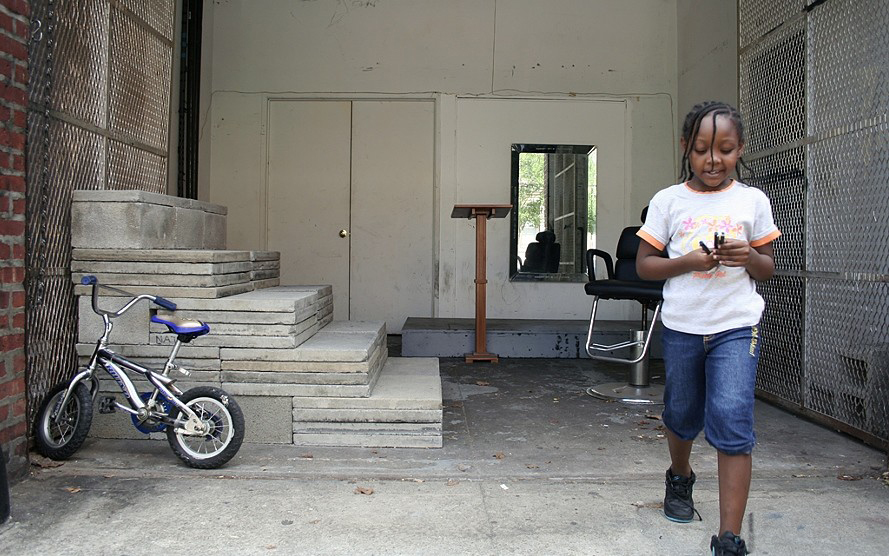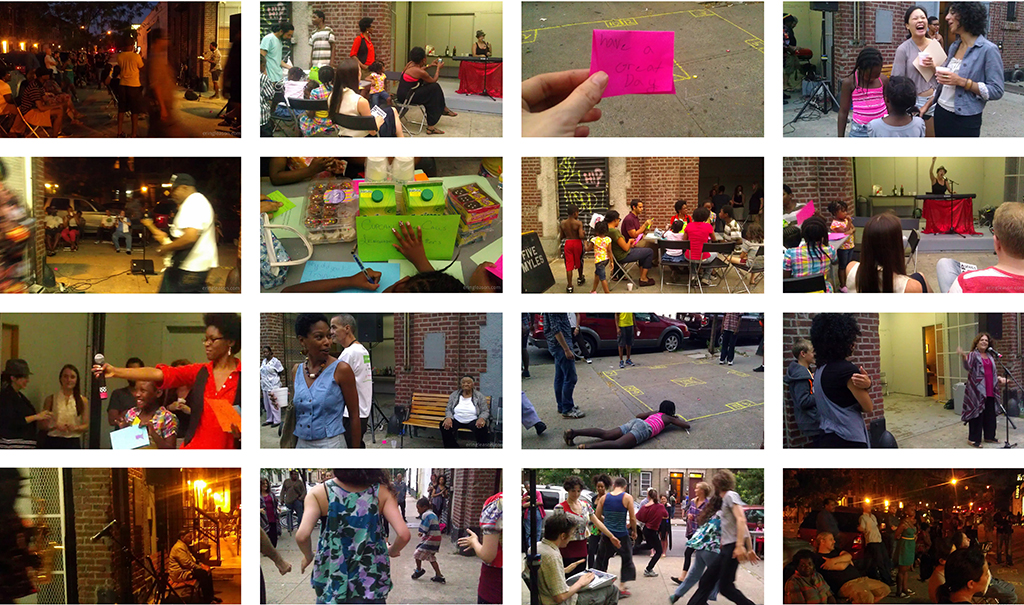
We are celebrating 15 years — and counting — of stories that are deeply researched and deeply felt, that build a historical record of what the city has been.
We are celebrating 15 years — and counting — of stories that are deeply researched and deeply felt, that build a historical record of what the city has been.
Writer and activist Parker Palmer describes a third thing as something that “allows us to hold challenging issues metaphorically, where they can’t devolve to the pro-or-con choices forced on us by conventional debate.” To me, this is what art is all about — creating a multi-layered space that inspires people to talk to one another and question their preconceptions. As an artist, I create work that challenges how we perceive, define, and shape space, and how space influences, defines, and shapes us. Much of that work examines how space itself can function and be elevated to a third thing or a “third space.”
I often use stoops as a motif and source of creative inspiration. Their evolution from purely utilitarian architecture to a site of cultural ritual first captivated me in 1990s Philadelphia, a city with a dynamic stoop culture. Coming from the Dutch word stoep, a stoop is defined simply as a small staircase ending with a platform used to enter a building. In Amsterdam they were used on elevated buildings to protect against flooding. When adopted in 19th-century America, stoop architecture served a more classist function. This is especially evident in New York City: with the city’s elimination of service alleyways, stoops provided formal access for family and guests to enter a home’s parlor without passing through the service rooms below. In essence, stoop architecture was a means of segregation, a way for the upper class to avoid “stooping” below their station by interacting with servants. By the end of the century, the cultural role of stoops transformed again as they became places for people to sit and gather, essentially functioning as a third space that blurs private and public life. A simple utilitarian staircase evolved into a social device that continues to shape public life in cities today.
When I moved to Edinburgh, Scotland, a city without a stoop culture despite its neighborhoods of grand stoops, I began to question what makes one culture adopt social practices around architectural elements while others do not. What cultural shift would trigger a stoop culture to develop in Edinburgh? Is this even possible? Searching for Edinburgh’s own third space equivalent, I recognized that the city’s myriad private gardens essentially function as Scottish stoops — privately owned property in visible, public spaces that define street environments. Exhibited at Tent Gallery in Edinburgh, my artwork My Very Own Private Garden plays with this public/private moment while reflecting Edinburgh’s topography and architecture that’s been designed with exclusivity in mind (there are 41 private parks in the New Town neighborhood alone). It was during the research for My Very Own Private Garden that the seeds of inspiration for the Mobile Stoop Project were planted.
The Mobile Stoop Project frees the stoop from its confines of geography and materiality by making stoops moveable and obtainable, no matter the location. Currently in development and seeking partners, the multi-phased project includes a series of exhibitions, products, and performances. The first phase includes an exhibition of 13 lightweight stoops, which can easily be moved and reconfigured by visitors. Straddling the line between utility and fine art, the artwork can be “used” for community stoop sales, debates, performances, games, and events, while serving as a contemplative space during quieter times.
The second phase will involve the fabrication of a series of limited-edition lightweight mobile stoops using surfboard construction as a model. These artworks can also be sold as indoor and outdoor furniture — a critical and cheeky take on the trend of branding, packaging, and exporting “urban” culture. The final phase of the project is a global tour of the exhibit, including curated salons and performances that will offer a framework for creative and cultural exchange. By providing a traveling platform for social engagement through mobile architecture, the Mobile Stoop Project celebrates the stoop as a means of connecting face-to-face in our increasingly impersonal, disconnected society, whether the mobile stoops are located in Brooklyn, Idaho, or Japan, or installed in an apartment living room, suburban strip mall, or airport lounge.
Since moving to Brooklyn from Scotland, a number of my recent projects have further explored the concept of space as a third thing and stoops as social devices. To Gather; an installation with curated performances exhibited at FiveMyles gallery in Crown Heights, Brooklyn, collected performers and architectural artifacts from a cross-section of the neighborhood’s social spaces. Part event, part installation, and part gathering place, the artwork brings a local perspective to urban flux and raises questions about varying perceptions of authenticity in a rapidly changing community. The installation in the gallery’s street-facing garage space includes a stoop constructed of cement blocks, a makeshift pulpit as a nod to the neighborhood’s disappearing storefront churches, and a simple barbershop, all referencing important community social spaces before the current gentrification tsunami hit. As a counterpoint, the opening night of the exhibition included performances by a talented group of artists, poets, musicians, and comedians I met in the “new” social spaces of Crown Heights — mainly coffee shops, bars, and restaurants. During opening night, members of the audience were encouraged to give their own impromptu performances. For the remainder of the exhibition, visitors were encouraged to hang out in the installation and use the artwork as their own gathering place.
Also held at FiveMyles, Stoop Series was a summer performance series co-curated with poet and editor Lynne Procope. Beginning each night with sidewalk games and chatter, the series brought together artists, poets, musicians, dancers, and storytellers with children and adults of the diverse local community in an intimate and playful setting. The gallery is located in a neighborhood with a vibrant stoop culture on a stretch of block without stoop architecture. With a nod to Jane Jacobs’ theory that stoops can be used as a design model to create active and lively urban streets while challenging the notion that the stoop itself is needed, Stoop Series examines the relationship between architecture, object, and social interaction. The gallery’s metaphorical stoop, in the form of a curated artwork, came to life with a fresh take on what the neighborhood’s stoops have long embodied — late evening conversation, cultural integration through chance encounters, storytelling, and play.
Participating in Suzanne Lacy’s Between the Door and the Street, a large-scale public performance sponsored by Creative Time and the Brooklyn Museum, offered an opportunity to experience a deceiving sense of intimacy that a stoop can create, even in the midst of a crowd of thousands. Lacy’s artwork engaged groups of women perched on 60 Brooklyn stoops and garbed in signature yellow pashminas to discuss issues of gender, race, ethnicity, and class. Each stoop along the street took on a unique emotive character, resonating with its own collective voice. Invited by writer and editor Syreeta McFadden to join the Feministing stoop along with five other women, our unscripted conversation paralleled many discussions we previously had together over Manhattans or at dinner parties. However this time, sitting on a stoop in front of a large audience, we delved deeper into these topics than we usually do and with more focus, sharing intimate parts of our lives we hadn’t shared with one another before. The stoop took on multiple roles, existing as a third space while also providing a natural fourth wall between our group and the audience. I couldn’t imagine this piece functioning as deeply, or as mystically, in a setting without stoops.
Several months earlier, I was honored to curate Cultural Fluency: Engagements with Contemporary Brooklyn as part of the Lori Ledis Curatorial Fellowship at the former BRIC Rotunda Gallery (now BRIC House). Much like Brooklyn’s stoops, I envisioned the entire show functioning as a third space and curated it with the aim for each artwork, the gallery space itself, and the exhibition’s promotional materials to spark multi-layered conversations. Cultural Fluency brought together six artists whose active and purposeful engagements with the city embody its culture. Their work — ranging from public art to photography to guerrilla opera bombs — depicts while also affecting society. This is a practice that American conceptual artist Joseph Kosuth cited in his 1975 essay “The Artist as Anthropologist”: “For the artist, obtaining cultural fluency is a dialectical process which, simply put, consists of attempting to affect the culture while he is simultaneously learning from (and seeking acceptance of) the same culture which is affecting him.” Nearly 40 years later, the artists in Cultural Fluency are doing precisely that, within the context of Brooklyn.
As part of the exhibition, a wide stoop was built not only as a podium to display artist Mark Reigelman’s Stair Squares (a public artwork created for the steps of Brooklyn’s Borough Hall), but also as an inviting place for contemplation, conversation, and hanging out. The podium — usually a passive means for displaying artwork — became an active piece of the gallery’s architecture and an artwork itself. It provided an intimate experience with the artwork and was a vehicle for social connection in the gallery. The stoop invited slowness in observation, created a shift in vantage point, and transformed the role of visitors from one of reception to participation. During Inside Cultural Fluency, the exhibition’s public program night, the stoop took on new life as a stage for artists’ dialogue and performances. The exhibition newspaper and online forum extended the metaphor of stoop as a third space by expanding the dialogue through a series of interviews with artists, architects, cultural producers, community activists, and politicians.
Examining the stoop as simultaneously a third thing, third space, and social device in my art practice is part of a wider research inquiry of space and place as cultural signifier. Does the spirit of a space exist without its material form? Can a virtual space become tangible? Can a space create language? What determines the meaning of a place? Who defines it? Can a space be transcendent? Is it possible to “make” a place? If so, why do we believe we can?
Maybe we can discuss one day, sitting on my stoop.
The views expressed here are those of the authors only and do not reflect the position of The Architectural League of New York.

